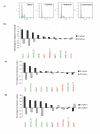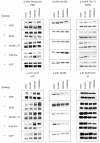Combination therapy with vemurafenib (PLX4032/RG7204) and metformin in melanoma cell lines with distinct driver mutations
- PMID: 21609436
- PMCID: PMC3152784
- DOI: 10.1186/1479-5876-9-76
Combination therapy with vemurafenib (PLX4032/RG7204) and metformin in melanoma cell lines with distinct driver mutations
Abstract
Background: A molecular linkage between the MAPK and the LKB1-AMPK energy sensor pathways suggests that combined MAPK oncogene inhibition and metabolic modulation of AMPK would be more effective than either manipulation alone in melanoma cell lines.
Materials and methods: The combination of the BRAF inhibitor vemurafenib (formerly PLX4032) and metformin were tested against a panel of human melanoma cell lines with defined BRAF and NRAS mutations for effects on viability, cell cycle and apoptosis. Signaling molecules in the MAPK, PI3K-AKT and LKB1-AMPK pathways were studied by Western blot.
Results: Single agent metformin inhibited proliferation in 12 out of 19 cell lines irrespective of the BRAF mutation status, but in one NRASQ61K mutant cell line it powerfully stimulated cell growth. Synergistic anti-proliferative effects of the combination of metformin with vemurafenib were observed in 6 out of 11 BRAFV600E mutants, including highly synergistic effects in two BRAFV600E mutant melanoma cell lines. Antagonistic effects were noted in some cell lines, in particular in BRAFV600E mutant cell lines resistant to single agent vemurafenib. Seven out of 8 BRAF wild type cell lines showed marginally synergistic anti-proliferative effects with the combination, and one cell line had highly antagonistic effects with the combination. The differential effects were not dependent on the sensitivity to each drug alone, effects on cell cycle or signaling pathways.
Conclusions: The combination of vemurafenib and metformin tended to have stronger anti-proliferative effects on BRAFV600E mutant cell lines. However, determinants of vemurafenib and metformin synergism or antagonism need to be understood with greater detail before any potential clinical utility of this combination.
Figures





References
-
- Kefford R, Arkenau H, Brown MP, Millward M, Infante JR, Long GV, Ouellet D, Curtis M, Lebowitz PF, Falchokk GS. Phase I/II study of GSK2118436, a selective inhibitor of oncogenic mutant BRAF kinase, in patients with metastatic melanoma and other solid tumors. Proc American Society of Clinical Oncology. 2010;28:611s.
Publication types
MeSH terms
Substances
Grants and funding
LinkOut - more resources
Full Text Sources
Other Literature Sources
Medical
Research Materials
Miscellaneous

